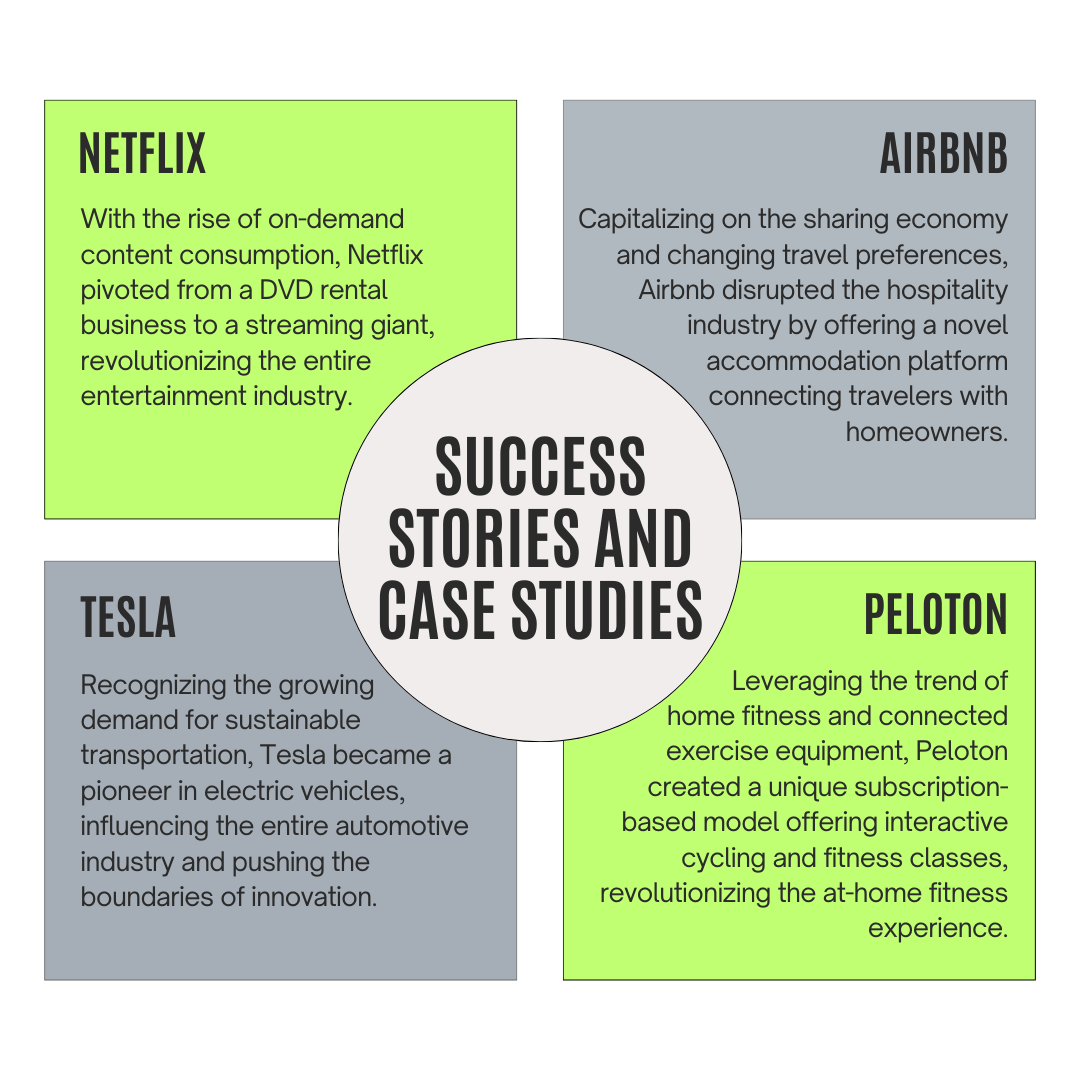
- Blog
How to identify and capitalize on emerging trends for growth?
By
HackLaunch
Capitalize on Emerging Trends for Business Growth: A Complete Guide
Feeling left behind? Don’t be. Discover the secret weapon of thriving businesses in today’s ever-evolving market: harnessing the power of emerging trends.
Imagine a world where you can predict the next big thing, not just react to it. Where you can transform your business and surpass your competitors by capitalizing on untapped market potential. This isn’t science fiction; it’s the reality for companies that embrace the art of identifying and capitalizing on emerging trends.
Whether you’re a budding startup or an established giant, this guide will equip you with the tools and strategies you need to navigate the ever-changing business landscape.
The business landscape is a dynamic arena where change is the only constant. To stay ahead of the competition, businesses must adapt – or better yet, anticipate – the trends shaping markets. Emerging trends, from shifting technologies to evolving consumer preferences, present unique opportunities for those who can spot them early and pivot strategically.
Whether you’re leading an agile startup or navigating an established corporation, understanding how to identify and capitalize on emerging trends is essential for sustainable growth. This comprehensive guide will equip you with the tools, frameworks, and strategies to transform trends into tangible business success.
Section 1: Identifying Emerging Trends
The business world is a dynamic ecosystem, constantly shifting and evolving. Staying ahead of the curve requires not just hard work, but also strategic foresight. Identifying emerging trends – shifts in technology, consumer behavior, regulations, or social consciousness – allows you to anticipate future market needs and position your business for sustainable growth. Here are several effective methods to become a trend-spotting pro:
- Industry Monitoring: Set up Google Alerts for relevant keywords, subscribe to industry publications, and follow thought leaders and influencers on social media platforms like LinkedIn and Twitter.
- Consumer Behavior Analysis: Analyze internal data like sales figures and customer feedback alongside external sources like social listening tools and search trend reports (e.g., Google Trends) to identify shifting consumer preferences and pain points.
- Technology Tracking: Stay informed about emerging technologies and their potential applications by following tech publications, attending industry conferences, and monitoring patent filings. Consider resources like Gartner Hype Cycles to understand the maturity level of different technologies.
- Network Participation: Expand your knowledge base by collaborating with startups, attending industry events (both online and in-person), and engaging in online communities like forums and discussion groups. This allows you to gain diverse perspectives and stay tuned into the latest industry buzz.
By actively employing these strategies, you’ll cultivate a culture of awareness within your organization, enabling you to identify emerging trends well before they reach mainstream status.
Section 2: Evaluating Trends for Potential
Not every shiny object deserves your company’s full attention. While staying ahead of the curve is crucial, discerning between fleeting fads and transformative shifts is equally important. Here’s a framework to assess the true potential of an emerging trend:
Alignment with Business Goals:
The first step is ensuring the trend aligns with your core mission and long-term vision. Chasing trends solely for the sake of novelty can be detrimental if it leads your business away from its fundamental purpose.
- Does the trend reinforce your company’s unique value proposition?
- Does it contribute to achieving your strategic objectives?
- Does it present an opportunity to expand into new markets that complement your existing offerings.
Remember, trend-driven growth should be a strategic decision, not an impulsive reaction.
Market Size and Growth:
Next, analyze the market size and growth potential associated with the trend. Is it a niche market with limited growth potential, or a broad market poised for significant expansion? Consider:
- Market research reports and industry data can provide insights into the size and projected growth of the market related to the trend.
- Utilize tools like Google Trends to analyze search volume and gauge consumer interest over time.
- Consult with experts like innovation consulting firms or venture capitalists who can offer valuable market insights and forecasts.
Focusing on trends with sustainable growth potential will ensure your efforts yield long-term value.
Competitive Landscape:
Understanding the competitive landscape surrounding the trend is crucial. Is the space already crowded with established players, or is there an opportunity for your company to carve out a unique niche? Consider:
- Competitor analysis: Identify your potential competitors in the emerging market and assess their strengths, weaknesses, and current strategies.
- Consider partnering with complementary businesses: Collaboration through open innovation or startup collaborations can help you navigate a crowded market and share resources.
- Regulatory Environment: Compliance Standards: Emerging trends can sometimes be accompanied by new regulations or evolving compliance standards. Consider the potential regulatory hurdles associated with the trend and ensure your business can adapt to meet any new requirements.
- Timing: Execution Moment: Carefully assess the timing of your entry into the market. Being an early adopter can be advantageous, but ensure the market is ready and the technology is mature enough to support your business model. Conversely, waiting too long might allow competitors to establish a strong foothold.
By thoroughly vetting the competitive landscape, you can determine your feasibility of success and develop a strategic approach to entering the market.
Resource Requirements:
Finally, honestly evaluate the resources required to capitalize on the trend. Does your company possess the necessary skills, technology, and financial resources to compete effectively? Consider:
- Skills and expertise: Does your team have the necessary skills and expertise to develop and launch products or services aligned with the trend?
- Technology and infrastructure: Does your company require additional technology or infrastructure investments to capitalize on the trend?
- Financial resources: Can your company afford the research and development (R&D) costs, marketing investments, and potential infrastructure upgrades required to pursue the trend?
Be realistic about your resource limitations and consider seeking external support through venture capital, accelerators, or innovation services if needed. By carefully evaluating these factors, you can make informed decisions about allocating resources and pursuing promising trends.
Section 3: Strategies for Capitalizing on Trends
Identifying the right trend is only half the battle. Now comes the exciting part: transforming that trend into tangible business growth. Here are several effective strategies you can employ:
Product/Service Innovation:
The most common way to leverage trends is by developing innovative products or services that cater to the evolving needs and desires signaled by the trend. This is where design thinking comes into play. It’s a human-centered approach to innovation that emphasizes understanding user needs, brainstorming creative solutions, and iterating quickly.
- Conduct extensive customer research to deeply understand the needs and pain points associated with the trend.
- Utilize design thinking methodologies to brainstorm innovative solutions and rapidly prototype potential offerings.
- Embrace agile development to iterate quickly, gather feedback, and refine your product or service based on user testing and market response.
- Consider product development strategies like lean startup methodologies to minimize upfront investment and prioritize continuous learning and improvement.
Remember, successful product/service innovation requires a deep understanding of your target market and the ability to translate trends into solutions that solve real problems.
Business Model Innovation:
Sometimes, emerging trends necessitate a rethink of your entire business model. This could involve exploring new revenue streams, modifying your pricing strategy, or even shifting from a product-based to a service-based model.
- Analyze how the trend disrupts existing industry norms and how it might impact traditional revenue models.
- Explore alternative business models such as subscriptions, freemium models, or platform models that might be better suited to capitalize on the trend.
- Consider partnering with other companies to create a more comprehensive offering or access new markets.
- Embrace experimentation and be willing to pivot your business model as you learn and gather market feedback.
Remember, successful business model innovation requires a willingness to challenge the status quo and explore unconventional approaches.
Additional Strategies:
Beyond product/service and business model innovation, several other strategies can enhance your ability to capitalize on trends:
- Process Optimization: Leverage emerging technologies and automation to streamline internal processes, reduce costs, and improve efficiency. This frees up resources to invest in growth areas aligned with the trend.
- Strategic Partnerships: Collaborate with startups, universities, or even competitors who possess expertise or resources relevant to the trend. Open innovation models and startup collaborations can accelerate your ability to learn and adapt.
- Marketing and Branding: Align your messaging and brand positioning with the trend. Target new audience segments, reframe your value proposition, and consider new marketing channels to reach your target market effectively.
- Diversification: Widening Scope: Consider how the trend can be leveraged to diversify your product or service offerings, potentially opening new revenue streams and expanding your market reach.
By implementing a combination of these strategies, you can effectively translate trends into real-world business success.
Section 4: Success Stories and Case Studies
Learning from the experiences of others is invaluable when navigating the ever-changing business landscape. Here are a few compelling examples of companies that successfully capitalized on emerging trends:

By analyzing their successes and challenges, you can glean valuable insights and apply those learnings to shape your own innovation strategy.
Section 5: Staying Ahead of the Curve
Creating a culture of innovation that actively seeks out and capitalizes on emerging trends is key to sustainable growth in today’s dynamic market. Here are some key steps to build such a culture:
Fostering a Culture of Innovation:
- Invest in innovation consulting services to help establish a strategic framework for identifying trends and fostering a culture of innovation within your organization.
- Promote open communication and encourage diverse perspectives to foster a creative environment where new ideas can flourish.
- Implement an innovation strategy that outlines your approach to identifying and capitalizing on trends, including employing relevant tools like growth hacking and embracing agile development methodologies.
Implementing an Innovation Strategy:
- Allocate dedicated resources to support your innovation efforts, including personnel, budget, and technology infrastructure.
- Encourage experimentation and risk-taking within a safe-to-fail environment that allows for learning from failures and iterating on ideas.
- Utilize design thinking methodologies to help your team approach challenges creatively and develop user-centric solutions.
Continuously Learning and Adapting:
- Maintain a focus on continuous learning by attending industry events, subscribing to relevant publications, and engaging in ongoing research and development (R&D) efforts.
Conclusion
In today’s dynamic market, identifying and capitalizing on emerging trends is no longer a luxury, but a necessity for sustainable growth.
By actively monitoring your industry, analyzing customer behavior, tracking technological advancements, and engaging with your network, you’ll gain a competitive edge in spotting the next big thing. Once you’ve identified a promising trend, evaluate its alignment with your business goals, assess its market potential, and develop a strategic plan to leverage it effectively. Remember, success stories like Netflix and Amazon are testaments to the transformative power of trend-driven business strategy.
Embark on your journey of becoming a trend-savvy business today. Foster a culture of continuous learning within your organization, embrace agility and adaptability, and build a diverse team to gain valuable insights from multiple perspectives. Remember, the future belongs to those who embrace change and actively shape their own destiny. So, start exploring, start strategizing, and start capitalizing on the power of emerging trends!
HackLaunch is a global collective team of entrepreneurs, startup founders and industry leaders that traverse strategy, marketing, tech, product and design to help businesses thrive and grow.
Share this post:
Table of Contents
INSIGHTS


